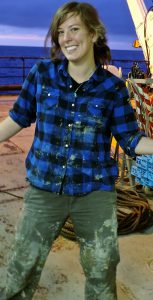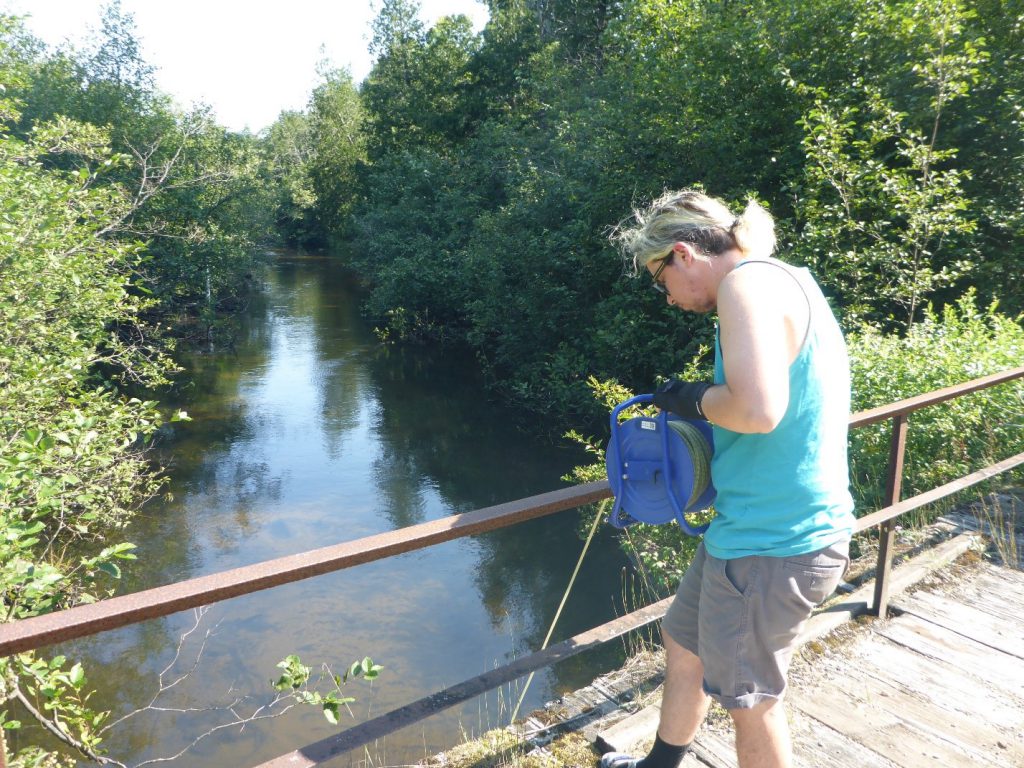 Research Interests
Research Interests
My research is focused on the geochemistry of modern and ancient sediments. Specifically, I employ a wide variety of tools including stable isotope and trace element geochemistry to reconstruct ancient environments. My previous work was focused on low-oxygen settings and understanding the role of anoxia on local and global ocean chemistry and ecology. Ongoing projects include reconstructing sulfur cycling in methane seep environments and the depositional history of the organic-rich Monterey Formation and its impact on and role in Miocene climate. Current work at Michigan State includes using nitrate nitrogen and oxygen isotopes to determine nitrogen sources to Michigan rivers, and using boron isotopes to quantify septic contamination in freshwater systems.
Education
Ph.D. The University of California Riverside, Earth Science
Graduate Advisor: Timothy W. Lyons
Dissertation Title: Proxy Applications for Reconstructing Carbon and Sulfur Cycling in Ancient Marine Environments
B.S. The University of Georgia, Geology
Recent Publications
Hancock, L.G., Hardisty, D.S., Behl R.J., and Lyons T.W., 2019, A multi-basin redox reconstruction for the Miocene Monterey Formation, California, USA: Palaeogeography, Palaeoclimatology, Palaeoecology., v. 520, p. 114-127, 10.1016/j.palaeo.2019.01.031.
Feenstra, E.J., Birgel, D., Heindel, K., Wehrmann, L.M., Jaramillo-Vogel, D., Grobety, B., Frank, N., Hancock, L.G., Van Rooij D., Peckmann, J., and Foubert A., in review, Constraining the formation of authigenic carbonates in a recent seepage affected cold-water coral mound by lipid biomarkers: Geobiology.
Walker, S.E., Hancock, L.G., Bowser, S.S., 2017, Diversity, biogeography, body size, and fossil record of parasitic and suspected parasitic foraminifera: A review: Journal of Foraminiferal Research, v. 47, p. 35-56.
Tarhan, L.G., Haddad, E., Solon, C.M., Dahl, R.M., Hancock, L.G, Henry, S.E., Joel, L.V., and Thompson, T.J., Droser, M.L., 2016, Seafloor colonization in the earliest Paleozoic: evidence from the Cambrian of Death Valley: Proceedings of the Death Valley Natural History Association, p. 3-27.
Loyd, S.J., Sample, J., Tripati, R.E, Defliese, W.F., Brooks, K., Hovland, M., Torres, M., Marlow, J., Hancock, L.G., Martin, R., Lyons, T.W., and Tripati, A.E., 2016, Methane seep carbonates yield clumped isotope signatures out of equilibrium with formation temperatures, Nature Communications, v. 7, article 12274.
Hancock, L.G., Walker, S.E., Perez-Huerta, A., and Bowser, S.S., 2015, Population dynamics and parasite load of a foraminifer on its Antarctic scallop host with their carbonate biomass contributions: PLOS ONE, 10(7): DOI: 10.1371/journal.pone.0132534.
Current CV
]]>
Research Interest
Generally, I have interests in interdisciplinary research to better understand the complexity of coupled human environment systems. Specially, I have focused on climate change, extreme climate events, landscape pattern evolution and their impacts on surface runoff, water quality and ecosystem services. Currently, my research involves nutrients transport in Great Lakes Basin using a spatially explicit modeling method, also nutrient simulations using a fully-coupled, process-based integrated hydrologic model in agricultural watersheds.
Education
2018-Present: Ph.D. student in Earth and Environmental Sciences, Michigan State University
2016-2017: visiting student in Agricultural and Biological Engineering, Purdue University
2014-2017: MS in Geography, South China Normal University
2010-2014: BS in Land Resource Management, Hunan Normal University
Recent Publications:
- Zhang, Z., Wan, L., Dong, C., Xie, Y., Yang, C., Yang, J. and Li, Y., 2018. Impacts of Climate Change and Human Activities on the Surface Runoff in the Wuhua River Basin. Sustainability, 10(10), p.3405.
- Chen, Y., Zhang, Z., Wan, L., Zhang, J., Yang, C., Ye, C. and Li, Q., 2018. Identifying Risk Areas and Risk Paths of Non-point Source Pollution in Wuhua River Basin. Acta Georaphica Sinica, 73(09), p. 1765-1777.
- Wan, L., Zhang, Z., Dong, C., Yang, C. and Zhang Z., 2017. The study on influence factors of hanjiang river basin of reference crop evapotranspiration change and its spatio-temporal change. Journal of south China normal university (natural science edition),49(04),p.73-81.
- Wan, L., Zhang, Z. and Li, Y., 2017. Temporal and spatial analysis of extreme temperature and precipitation events in hanjiang river basin during the past 50 years. Journal of China Agricultural University, 22 (09), p.133-144.
- Li, Y., Zhang, L., Qiu, J., Yan, J., Wan, L., Wang, P., Hu, N., Cheng, W. and Fu, B., 2017. Spatially explicit quantification of the interactions among ecosystem services. Landscape Ecology, 32(6), pp.1181-1199.

I grew up in a small farming suburb of Grand Rapids, Michigan where my parents greatly enforced the value of curiosity and discovery. Being surrounded by freshwater my entire life fostered a deep appreciation for the environment and the dynamic interactions between humans and varying ecosystems. During my undergraduate experience at The Ohio State University, I was able to utilize my passion as well as supporting coursework to perform research of groundwater contamination. My Bachelor’s Thesis redirected my interests from analyzing water issues that had already occurred to prevention of water issues that may arise. In my graduate education, my goal is to directly impact people in a positive way through science discovery which is why I work with the Hydrogeology Lab at MSU.
Research Interests
I am interested in the effects of anthropogenic water use on overall environmental, economic, and energetic sustainability. A majority of water withdrawal is used for agricultural irrigation, and irrigation is paramount to sustainability. Through data analysis and the use of models created by the hydrogeology lab, the USGS, and more, I investigate the impacts of agricultural irrigation on the energy footprint and water resources of the Central Valley in California.
Education
- PhD Student August 2018-Present, Environmental Geosciences, Michigan State University
- BS Earth Sciences 2014, The Ohio State University, magna cum laude, with Honors in Arts & Sciences, and Honors Research Distinction in Earth Sciences
Recent Abstracts
- Brady, A.J., Schwartz, F.W., 2018, Serendipity in events leading to groundwater contamination in Elkhart, IN. The Denman Undergraduate Research Forum. Columbus, OH.
- Brady, A.J., Schwartz, F.W., 2017, Groundwater contamination caused by serendipitous events at Elkhart, IN. Geological Society of America Annual Meeting. Seattle, WA.
 Research Interests
Research Interests
Cycles of nitrogen and phosphorus have been driven out of balance by anthropogenic processes. My work seeks to understand nutrient sources and transport at regional scales. As an NSF graduate research fellow, I led development on the Spatially Explicit Nutrient Source Map (SENSMap) in the Great Lakes Basin, a product that quantifies seven N and P source applications at 30 m resolution. I am interested in modelling the fate of these nutrient applications as they move across the land surface and through groundwater.
Education
MS Student September 2017 – present, Environmental Geosciences, Michigan State University
BS Geographic Information Science 2017, Michigan State University
Recent Works
Hamlin, Quercus F., Kendall, Anthony D., Martin, Sherry L., Whitenack, Henry D., Roush, Jacob A., Hannah, Bailey A., Hyndman, David W. “Spatially Explicit Nutrient Source Map (SENSMap): Quantifying Landscape Nutrient Inputs in the Great Lakes Basin.” Journal of Geophysical Research: Biogeosciences (In Review)
Hamlin, Quercus F., Kendall, Anthony D., Martin, Sherry L., Hyndman, David W. “Quantifying Nutrient Loading Landscapes using Spatially Explicit Maps in the Great Lakes Basin”. Poster. American Geophysical Union Fall Meeting. 12 December 2018.
Hamlin, Quercus F., Kendall, Anthony D., Martin, Sherry L., Hyndman, David W. “Quantifying Nutrient Inputs in the Great Lakes Basin with SENSMap (Spatially Explicit Nutrient Source Map)”. Oral. US International Association for Landscape Ecology Annual Meeting. 11 April 2018.
]]>

Higgins Lake is Michigan’s 10th largest inland lake, and one of its deepest. Despite its long history of clean water, Higgins Lake is experiencing changes in water quality, underwater vegetation, invasive species, and Swimmer’s Itch. Many of these changes impact the shallow region near shore, in the area called the shelf. The current water quality monitoring program focuses on the deeper areas of Higgins Lake. These measurements are not always the same in the shallower regions of the lake.
The area surrounding Higgins Lake includes two state parks, >1300 riparian landowners and thousands of residents in the surrounding townships. In 1996, a USGS study of Higgins Lake reported a link between residential density and lower water quality due to nutrient contamination. The majority of the shoreline of Higgins Lake is populated by septic-served homes. These septic systems may act as a major source of near-shore nutrient contamination, especially during high occupancy times, such as summer.

The water quality of Higgins Lake is routinely measured by volunteers from the Cooperative Lakes Monitoring Program. However, these measurements are taken in the deepest sections of the lake and do not accurately represent the shallow shelf area. Measurements from the North Basin usually display relatively low nutrients levels (about 10ug/L Total Phosphorus). However, nutrient levels in the near-shore area of the lake are significantly higher (image). According to the Trophic State Index, the shelf water is hypereutrophic (excessively high nutrients).
This study looks at the linkages between septic systems and near-shore water quality. One hypothesis is that areas of higher nutrient levels may result in hot spots for snails (an intermediate host for Swimmer’s Itch parasites, family Schistosomatidae) and may, thus, increase the risk of Swimmer’s Itch in those areas. The work includes collecting water quality samples in the near-shore area around Higgins Lake and characterizing the location of septic-served households using remote sensing, high-resolution sampling and chemical markers. The study will: 1) provide a 20-year follow-on to portions of a 1996 USGS report studying the water quality of Higgins Lake with regard to residential development, 2) establish a baseline of concentrations of so-called emerging contaminants and non-traditional chemical fingerprints (for instance caffeine, triclosan, and estrogen), 3) identify hot-spots of septic system contamination and inputs, and 4) link these inputs to recreational and human health concerns.
]]>